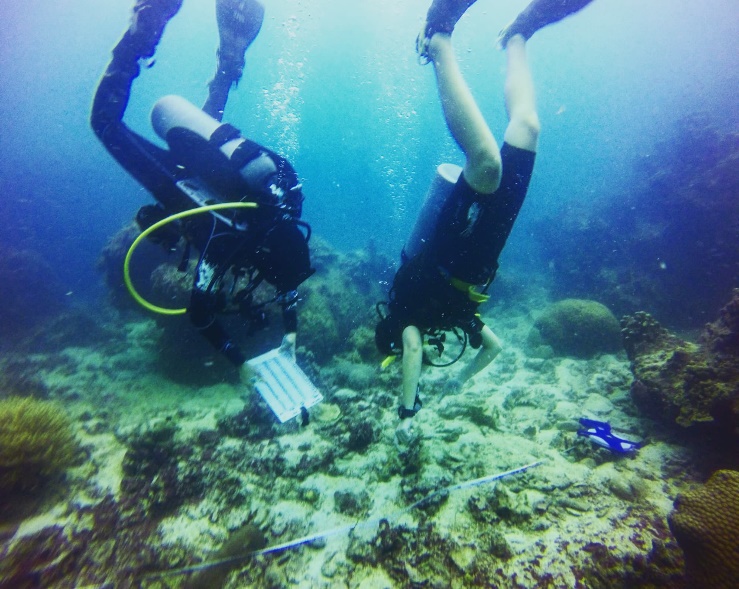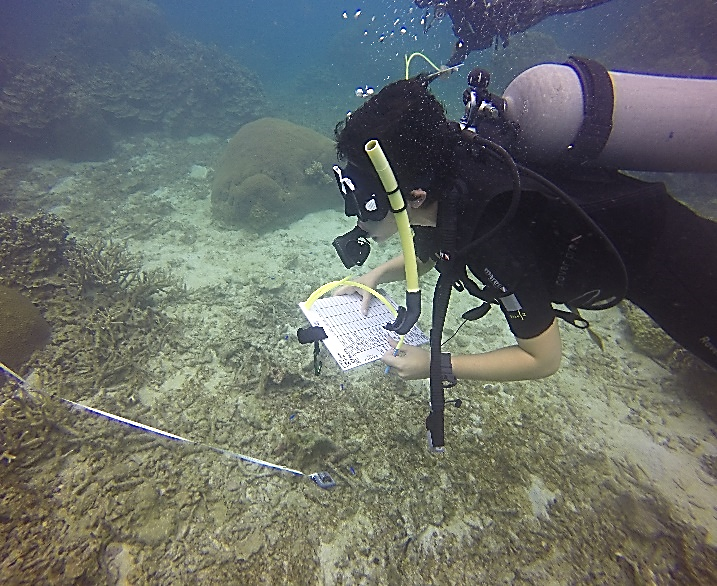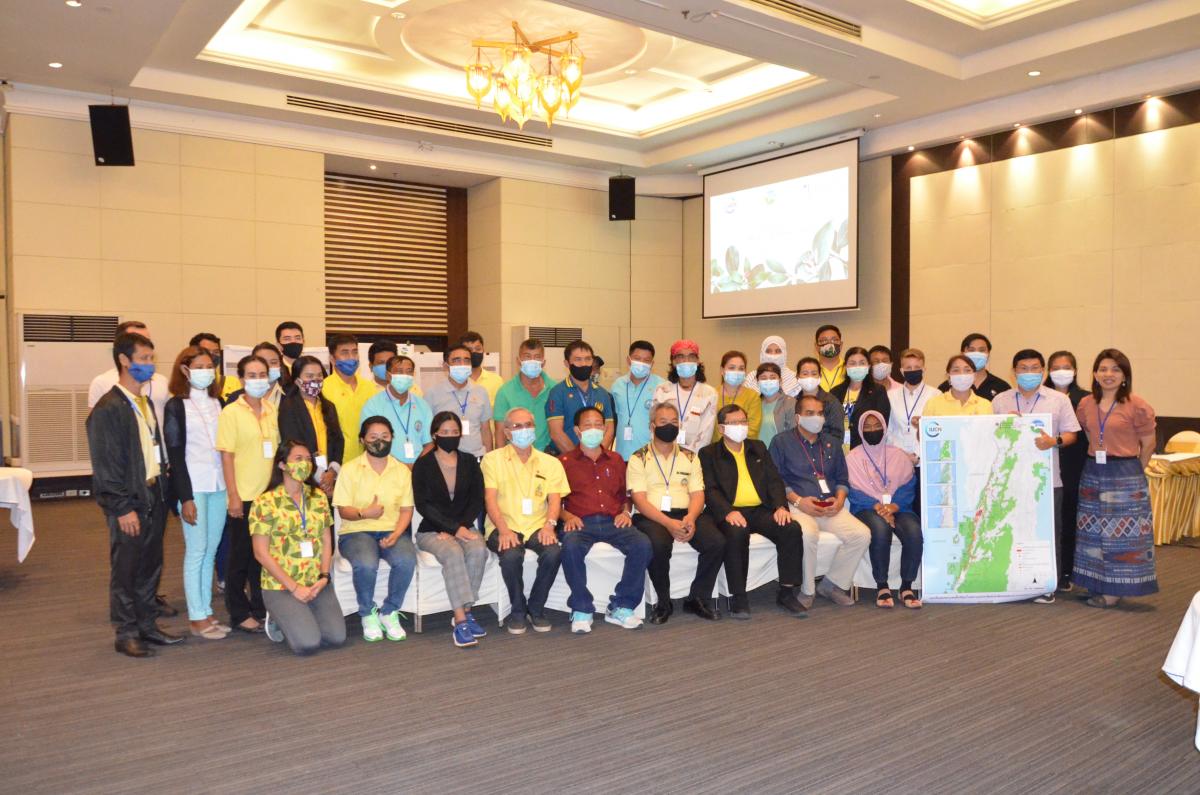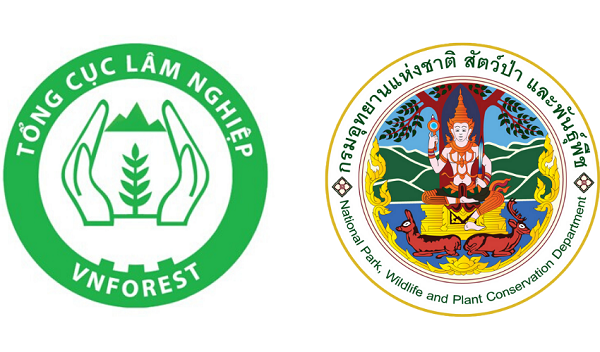Putting people at the heart of ocean conservation
Blog by Ria Sen, member of the IUCN Comission on Education and Communication, following Global AWARE Week

The author and another diver conduct a substrate survey as part of Reef Check certification training
Photo: © Eco Koh Tao
Last week I was in Koh Tao – called the “diver’s paradise” of Thailand – where I keenly participated in marine conservation activities as part of AWARE Week 2018, supported by Project AWARE and PADI. A global first, AWARE Week sought to make divers ocean advocates and actors for change. The intent was to place people at the centre of ocean conservation actions, by practically educating both divers and the wider public on the ocean’s value.
This event comes at a pressing time, when the global marine pollution situation is very acute. According to UNESCO’s Intergovernmental Oceanographic Commission (IOC), around 80% of marine pollution originates on land, and an excess of nutrients from sewage and agricultural runoff have created low-oxygen “hypoxic” areas known as dead zones where most marine life perishes. This then results in the collapse of some critical ecosystems. According to the IOC, there are an estimated 500 dead zones covering more than 245,000 km² globally – just about the surface of the United Kingdom.
As far back as 2006, the United Nations Environment Programme estimated that every square mile of ocean contains 46,000 pieces of floating plastic. It is safe to say this number is still rising considerably, as more than 220 million plastic items are manufactured annually. Plastic materials and litter can accumulate in certain areas due to oceanic currents, called “gyres.” Alarmingly, there are now five growing gyres in our oceans – the North Atlantic, South Atlantic, North Pacific, South Pacific, and Indian Ocean Gyres.
Once discarded, plastics weather and erode into very small pieces known as microplastics, which are often ingested by marine creatures, resulting in illness and death. It is sobering to learn that plastic debris kills more than a million seabirds every year, as well as more than 100,000 marine mammals. Often these plastic items are single-use, which makes it all the more critical for us to make informed consumer choices.
An amalgamation of factors compound the challenge for conserving oceans: unsustainable agricultural practices, growing ocean-based tourism, rapid port and harbour development, damming of rivers (which can impact sediment flow downstream), unplanned urban development and construction, heavy metal contamination from mining, large-scale fisheries and aquaculture, and unregulated manufacturing, amongst others.
Hearteningly, steps against marine pollution and actions for supporting reef conservation are being taken. This year, AWARE Week offered divers a chance to acquire a “Dive Against Debris” specialty, which trains divers to be mindful of debris, how to collect it, and how to record their observations. PADI has launched a dedicated app for divers to submit their findings, which also allows them to upload images and detail the kinds of debris they encounter. It’s a quick and easy way to record marine pollution on a global scale. Reef surveying initiatives also provide useful outlets for documenting incidents of marine pollution and the status of coral health.
During AWARE Week, together with a small team of inspiring women, I underwent training to become Reef Check certified, under the guidance of marine conservationist Jennifer Dowling of Eco Koh Tao. This qualification enables certified divers to undertake reef surveys globally. Survey results can inform policy and planning, ultimately improving the management of reefs as a vital ecosystem. Established in 1996, the Reef Check Foundation – the certifying body – exists to preserve oceans and reefs. Currently, volunteer teams exist in more than 90 countries and territories, actively protecting reefs through a combination of education, research and conservation.
The Reef Check monitoring protocol was introduced to our team through a combination of theory and practice. It involved a comprehensive approach for surveying substrates (the surface on which marine life grows), invertebrates and fish, as well as for the data entry procedures.
 The author, Ria Sen, records data from a substrate survey
Photo: © Eco Koh Tao
The author, Ria Sen, records data from a substrate survey
Photo: © Eco Koh Tao
As a very newly advanced open water diver, it was an extremely humbling experience to participate in this Reef Check course. It was also very challenging remaining still as a rock in a head-down position for a long time and being neutrally buoyant! I overcame some bouts of vertigo and understood that less is more – in terms of movement and speed – when taking underwater surveys.
The Reef Check data recording templates have sections for recording trash observed and incidents of coral ill health, such as bleaching and algal proliferation, which indicates the level of nutrients in the water. Divers may collect the trash they find during surveys and stow it in mesh bags, or even in empty pockets – as our team did during the survey dives. This is a good practice for “diving against debris” and can even be practiced during fun dives with a little training! As a marine conservationist, I believe Reef Check has enabled me to better understand and document underwater life and its health. Improving my diving and surveying skills can enable me to take some action!
Whilst the global marine pollution situation is dire, I do believe putting people at the heart of conservation action brings the situation under our control, and makes it less a scenario of impending doom. I enjoyed this meaningful read by National Geographic which outlines 10 easy steps for being an advocate for marine conservation, by making informed life choices.
Every step counts. Think of the marine lives being saved just by conscious actions. Safeguarding ecosystems means benefits for all living beings – underwater and on land!



